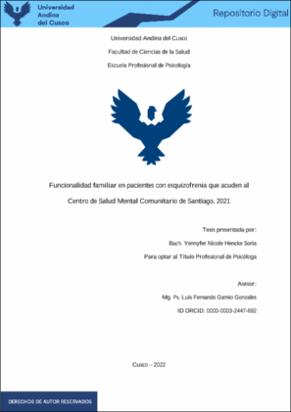| dc.contributor.advisor | Gamio González, Luis Fernando | |
| dc.contributor.author | Hencke Soria, Yennyfer Nicole | |
| dc.date.accessioned | 2023-04-03T15:12:34Z | |
| dc.date.available | 2023-04-03T15:12:34Z | |
| dc.date.issued | 2022-12-16 | |
| dc.identifier.uri | https://hdl.handle.net/20.500.12557/5293 | |
| dc.description.abstract | El estudio corresponde al alcance descriptivo de diseño no experimental y de enfoque
cuantitativo, que tuvo como objetivo identificar el nivel de funcionalidad familiar de los
pacientes con esquizofrenia que acuden al Centro de Salud Mental Comunitario de Santiago
de la ciudad del Cusco, evaluando la dimensión de adaptabilidad y de cohesión familiar para
poder conocer la dinámica de la familia, tomando en cuenta la percepción del paciente y de
un familiar a cargo. La investigación conto con la muestra de 35 pacientes y 35 familiares.
La herramienta aplicada fue FACES III que fue creado por Olson, Russell y Sprenkle. Con
los resultados se demostró que la funcionalidad familiar de pacientes (65.7%) y de familiares
(80%) que se evaluaron según la dimensión de cohesión pertenece al nivel bajo de tipo
desligada y según la dimensión de adaptabilidad pertenece al nivel moderado de tipo flexible
y estructural. En tanto, la conclusión de esta investigación es que una gran parte de los
pacientes y familiares son de nivel moderado de funcionalidad familiar, siendo estas de tipo
estructurada desligada y flexible desligada. | es_PE |
| dc.description.abstract | The study corresponds to the descriptive scope of a non-experimental design and a
quantitative approach, which aimed to identify the level of family functionality of patients
with schizophrenia who attend the Santiago Community Mental Health Center in the city of
Cusco, evaluating the dimension of adaptability and family cohesion in order to know the
dynamics of the family, taking into account the perception of the patient and a family
member in charge. The investigation had a sample of 35 patients and 35 relatives. The
applied tool was FACES III which was created by Olson, Russell and Sprenkle. With the
results, it was demonstrated that the family functionality of patients (65.7%) and relatives
(80%) that were evaluated according to the cohesion dimension belongs to the low level of
the detached type and according to the adaptability dimension it belongs to the moderate
level of the flexible type. and structural. Meanwhile, the conclusion of this research is that a
large part of the patients and relatives have a moderate level of family functionality, being
these of the structured detached and flexible detached type. | en_US |
| dc.format | application/pdf | es_PE |
| dc.language.iso | spa | es_PE |
| dc.publisher | Universidad Andina del Cusco | es_PE |
| dc.rights | info:eu-repo/semantics/openAccess | es_PE |
| dc.rights.uri | https://creativecommons.org/licenses/by-nc-nd/4.0/ | es_PE |
| dc.subject | Pacientes mentales | es_PE |
| dc.subject | Manejo de la enfermedad | es_PE |
| dc.subject | Adaptabilidad familiar | es_PE |
| dc.title | Funcionalidad familiar en pacientes con esquizofrenia que acuden al Centro de Salud Mental Comunitario de Santiago, 2021 | es_PE |
| dc.type | info:eu-repo/semantics/bachelorThesis | es_PE |
| thesis.degree.name | Psicóloga | es_PE |
| thesis.degree.grantor | Universidad Andina del Cusco. Facultad de Ciencias de la Salud | es_PE |
| thesis.degree.discipline | Psicología | es_PE |
| dc.publisher.country | PE | es_PE |
| dc.subject.ocde | https://purl.org/pe-repo/ocde/ford#5.01.00 | es_PE |
| renati.advisor.dni | 43793076 | |
| renati.advisor.orcid | https://orcid.org/0000-0003-2447-692 | es_PE |
| renati.author.dni | 72094081 | |
| renati.discipline | 313016 | es_PE |
| renati.juror | Masias Ynocencio, Isabel | |
| renati.juror | Izquierdo Concha, Magaly | |
| renati.juror | Boisseranc Bonett, María Del Carmen Virginie | |
| renati.juror | Peña Farfán, María Liliana | |
| renati.level | https://purl.org/pe-repo/renati/level#tituloProfesional | es_PE |
| renati.type | https://purl.org/pe-repo/renati/type#tesis | es_PE |


